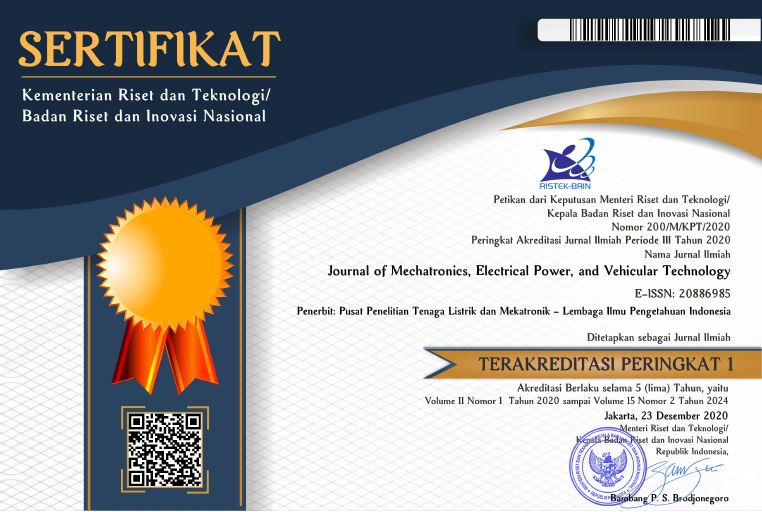LSTM-based forecasting on electric vehicles battery swapping demand: Addressing infrastructure challenge in Indonesia
Abstract
This article aims to design a model for forecasting the number of vehicles arriving at the battery swap station (BSS). In our case, we study the relevance of the proposed approach given the rapid increase in electric vehicle users in Indonesia. Due to the vehicle electrification program from the government of Indonesia and the lack of supporting infrastructure, forecasting battery swap demands is very important for charging schedules. Forecasting the number of vehicles is done using machine learning with the long short-term memory (LSTM) method. The method is used to predict sequential data because of its ability to review previous data in addition to the current input. The result of the forecasting using the LSTM method yields a prediction score using the root-mean-square error (RMSE) of 2.3079 x 10-6 . The forecasted data can be combined with the battery charging model to acquire predicted hourly battery availability that can be processed further for optimization and scheduling.
Keywords
Full Text:
PDFReferences
United Nations Climate Change. The Paris Agreement. [Accessed: 8-June-2023].
The Central Government. Presidential Regulations on Accelerating the Battery-Based Electric Vehicle Program for Road Transport. [Accessed: 7-June-2023].
Y. Li et al., “Optimal scheduling of isolated microgrid with an electric vehicle battery swapping station in multi-stakeholder scenarios: A bi-level programming approach via real-time pricing,” Appl. Energy, vol. 232, pp. 54–68, Dec., 2018.
M. Sufyan, N. A. Rahim, M. A. Muhammad, C. K. Tan, S. R. S. Raihan, and A. H. A. Bakar, “Charge coordination and battery lifecycle analysis of electric vehicles with V2G implementation,” Electric Power Systems Research, vol. 184, p. 106307, Jul., 2020.
J. G. -Guarin, W. Infante, J. Ma, D. Alvarez, and S. Rivera, “Optimal scheduling of smart microgrids considering electric vehicle battery swapping stations,” International Journal of Electrical and Computer Engineering (IJECE), vol. 10, no. 5, p.5093, Oct., 2020.
M. S. Islam, N. Mithulananthan, and D. Q. Hung, “A Day-Ahead
Forecasting Model for Probabilistic EV Charging Loads at Business Premises,” IEEE Trans Sustain. Energy, vol. 9, no. 2, pp. 741–753, Apr., 2018.
R. Ghotge, Y. Snow, S. Farahani, Z. Lukszo, and A. van Wijk, “Optimized Scheduling of EV Charging in Solar Parking Lots for Local Peak Reduction under EV Demand Uncertainty,” Energies (Basel), vol. 13, no. 5, p. 1275, Mar., 2020.
N. Kaewdornhan, C. Srithapon, R. Liemthong, and R. Chatthaworn, “Real-Time Multi-Home Energy Management with EV Charging Scheduling Using Multi-Agent Deep Reinforcement Learning Optimization,” Energies (Basel), vol.16, no. 5, p. 2357, Mar., 2023.
H. Wu, G. K. H. Pang, K. L. Choy, and H. Y. Lam, “An Optimization Model for Electric Vehicle Battery Charging at a Battery Swapping Station,” IEEE Trans. Veh. Technol., vol. 67, no. 2, pp. 881–895, Feb., 2018.
X. Zhang, Y. Cao, L. Peng, N. Ahmad, and L. Xu, “Towards Efficient Battery Swapping Service Operation Under Battery Heterogeneity,” IEEE Trans. Veh. Technol., vol. 69, no. 6, pp. 6107–6118, Jun., 2020.
Q. Lin, J. Wang, R. Xiong, W. Shen, and H. He, “Towards a smarter battery management system: A critical review on optimal charging methods of lithium ion batteries,” Energy, vol. 183, pp. 220–234, Sep., 2019.
M. Xu, R. Wang, P. Zhao, and X. Wang, “Fast charging optimization for lithium-ion batteries based on dynamic programming algorithm and electrochemical-thermal capacity fade coupled model,” J. Power Sources, vol. 438, p. 227015, Oct., 2019.
Y. Li, K. Li, Y. Xie, J. Liu, C. Fu, and B. Liu, “Optimized charging of lithium-ion battery for electric vehicles: Adaptive multistage constant current–constant voltage charging strategy,” Renew. Energy, vol. 146, pp. 2688–2699, Feb., 2020.
Y.-H. Chiang, W.-Y. Sean, and J.-C. Ke, “Online estimation of internal resistance and open-circuit voltage of lithium-ion batteries in electric vehicles,” J. Power Sources, vol. 196, no. 8, pp. 3921–3932, Apr., 2011.
M. C. Argyrou, P. Christodoulides, C. C. Marouchos, and S. A. Kalogirou, “Hybrid battery-supercapacitor mathematical modeling for PV application using Matlab/Simulink,” in 2018 53rd International Universities Power Engineering Conference (UPEC), IEEE, Sep., 2018.
B. Yegnanarayana, Artificial Neural Networks. Delhi: PHI Learning Pvt. Ltd., 2009.
J. L. Smith, “Advances in neural networks and potential for their application to steel metallurgy,” Materials Science and Technology, vol. 36, no. 17, pp. 1805–1819, Nov., 2020.
Z. Niu, Z. Yu, W. Tang, Q. Wu, and M. Reformat, “Wind power forecasting using attention-based gated recurrent unit network,” Energy, vol. 196, p. 117081, Apr., 2020.
Y. Zhang, J. Tang, Z. He, J. Tan, and C. Li, “A novel displacement
prediction method using gated recurrent unit model with time series analysis in the Erdaohe landslide,” Natural Hazards, vol. 105, no. 1, pp. 783–813, Jan., 2021.
Y. Yu, X. Si, C. Hu, and J. Zhang, “A Review of Recurrent Neural
Networks: LSTM Cells and Network Architectures,” Neural Comput., vol. 31, no. 7, pp. 1235–1270, Jul., 2019.
K. Smagulova and A. P. James, “A survey on LSTM memristive
neural network architectures and applications,” Eur. Phys. J. Spec. Top., vol. 228, no. 10, pp. 2313–2324, Oct., 2019.
A. A. Shalaby, M. F. Shaaban, M. Mokhtar, H. H. Zeineldin, and E.
F. El-Saadany, “A Dynamic Optimal Battery Swapping Mechanism for Electric Vehicles Using an LSTM-Based Rolling Horizon Approach,” IEEE Transactions on Intelligent Transportation Systems, vol. 23, no. 9, pp. 15218–15232, Sep., 2022.
Article Metrics
Metrics powered by PLOS ALM
Refbacks
- There are currently no refbacks.
Copyright (c) 2023 Journal of Mechatronics, Electrical Power, and Vehicular Technology

This work is licensed under a Creative Commons Attribution-NonCommercial-ShareAlike 4.0 International License.




















